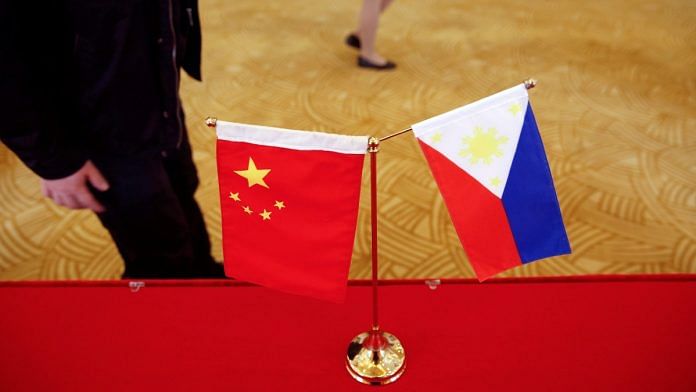The South China Sea, not Taiwan, is the flashpoint, remarked Jose Manuel Romualdez, the Philippines’ Ambassador to the United States, in December 2023. Judging by the ongoing war of words between China and the Philippines, Romualdez’s assertion appears to be accurate.
The protracted verbal skirmish between the two countries has extended its reach across various channels, encompassing official statements and numerous social media platforms. Both parties have actively engaged in provocative exchanges. Hu Xijin, former editor-in-chief of the Global Times, termed Romualdez’s comments as ‘laughable’, and further implied that “the Philippine hawks are receiving support and encouragement by the Americans to fight China.
This online clash has escalated further. On 15 January, Philippines’ President Ferdinand Marcos Jr. wrote a congratulatory message for Taiwan’s President-elect Lai Ching-te on X. This prompted the Chinese foreign ministry to summon the Philippines’ ambassador and warn the country to “not play with fire.” Ministry spokesperson Mao Ning deemed it a serious violation of the One China principle, a gross interference in China’s internal affairs, and a significant breach of the political commitments made by the Philippines to the Chinese side.
Taking a step further, Mao suggested President Marcos “read books” to understand the intricacies of the Taiwan issue. The ministry’s website later revised this suggestion to “develop a proper understanding of the ins and outs of the Taiwan question and come to a right conclusion”, following backlash from the Philippines. Gilberto C. Teodoro Jr., Philippines’ Secretary of National Defense, categorised Mao’s remarks as “gutter-level talk.” The South China Sea issue is giving rise to a new form of dysfunctional diplomacy, where conventional methods are being cast aside.
Also read: Days after China-Philippines skirmish in South China Sea, Indian warship at Manila to bolster ties
What’s the Philippines’ South China Sea Approach?
Marcos’ congratulatory messages to Taiwan’s president-elect were not about him showing solidarity with Taiwan and cherishing the power of democracy; he merely used Taiwan as a bargaining chip. His stance was a consequence of Beijing’s assertive actions in the South China Sea.
In a 23 January interview, Marcos said that “he does not endorse Taiwan’s independence” and reiterated his country’s commitment to the One-China policy. His subsequent reversal has been mocked on the Chinese microblogging site Weibo, with several users remarking that Marcos may have finally familiarised himself with pertinent literature on the Taiwan question. This development occurred in the wake of reports indicating China and the Philippines’ willingness to de-escalate tensions on 17 January.
Seeking to reassure China on the Taiwan issue has not yielded significant advantages for the Philippines. While Marcos’ comments prompted China to engage with the Philippines, it is only leading to a temporary cessation of hostilities. The prolonged South China Sea dispute has witnessed China fortifying its position, with much of its actions going unchecked. In fact, some recent reports revealed a direct confrontation between the Chinese Coast Guard and Filipino fishermen on 12 January, emphasising persistent challenges.
Although Marcos attempted to ease tensions with China following his remarks on Taiwan, his South China Sea strategy still remains effective. The strategic emphasis on using the ‘West Philippines Sea’ instead of the South China Sea has allowed the country to shape a distinct narrative both online and in diplomatic engagements with other countries.
Moreover, the Philippines’ continues with its approach of aligning with like-minded countries to navigate issues with China. Notably, the country is shifting away from relying on a unified ASEAN (Association of Southeast Asian Nations) approach and increasingly seeking partnerships with other similarly inclined countries. Key examples of this trend include the Philippines strengthening ties with both India and the US. India particularly supported the 2016 arbitration ruling in favour of the Philippines, highlighting a shared interest in upholding international law.
In November last year, the US state department affirmed America’s unwavering solidarity with the Philippines amid Beijing’s “repeated harassment” in the South China Sea. It emphasised that “Article IV of the 1951 U.S.-Philippines Mutual Defense Treaty extends to armed attacks on Philippine armed forces, public vessels, or aircraft – including those of its Coast Guard – anywhere in the South China Sea.”
Also read: Philippines hits out at China, accuses it of ‘low & gutter-level talk’ on Taiwan
Is there a solution?
China continues to view individual Southeast Asian claimants in the South China Sea as more easily influenced, employing a divide-and-rule strategy and wooing weaker and smaller countries to perpetuate the dispute. The prolonged inability of China to create even a non-binding code of conduct underscores its reluctance to genuinely address differences.
India’s former foreign secretary Vijay Gokhale recently emphasised that “China understands the language of strength” – a principle applicable not only to the India-China border standoff but also to the South China Sea dispute. As Marcos retracts his Taiwan stance, a familiar pattern emerges, where China seems inclined to offer momentary appeasement only when tensions flare. Currently grappling with a sluggish economy, a standoff with India, and anticipating the prospects of US-China relations in the aftermath of America’s elections, China perceives it in its interest to project an illusion of temporary peace—at least until these pressing issues are resolved.
While the Philippines, under Marcos, has thus far demonstrated resolve in holding its ground, what is now crucial is a consistent and steadfast approach in dealing with Beijing’s actions in the South China Sea. This approach should include refraining from retracting statements that cross China’s so-called redlines.
Sana Hashmi, PhD, is a fellow at the Taiwan-Asia Exchange Foundation and George HW Bush Foundation for US-China Relations. She tweets @sanahashmi1. Views are personal.
(Edited by Zoya Bhatti)



